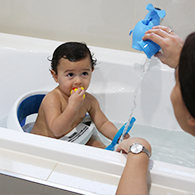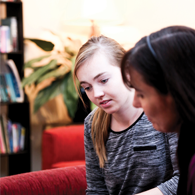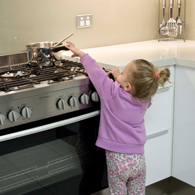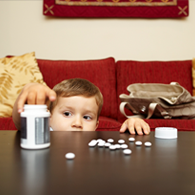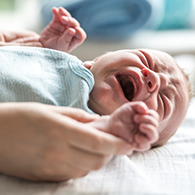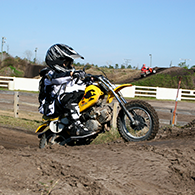Child car restraints
What are child car restraints?
Child car restraints are seats designed to protect children travelling in a motor vehicle in the event of a crash. Child car restraints have proven to be safer for children than adult seat belts.
There are many types of child car restraints available. Your child’s age and size determines which child restraint is most appropriate. A guide to help you choose an appropriate restraint is provided below. Use this in conjunction with manufacturer recommendations.
Birth to 6 months
Rearward facing infant restraints with an inbuilt harness are to be used fom birth through to approximately six months of age. In these restraints, your baby faces the back of the car during travel.
Aged 6 months up to 4 years
From 6 months to approximately 4 years of age children should use a rearward or forward facing child restraint with an inbuilt harness. These restraints are designed to hold young children who are able to support their head while seated.
Aged 4 years up to 7 years
Forward facing child seats are suitable for children aged 4-7 years. These seats may have an inbuilt harness or amy be used in combination with the adult lap-sash seatbelt.
Convertible restraints combine two or more of the above features and can therefore be used for a longer period of time by changing the mode, as required.
A guide for when your child can safelty use an adult lap-sash seatbelt is the 5 step test.
Your child can sit with their lower back against the back of the seat
Their knees can bend over the edge of the seat
The sash part of the seatbelt goes across the middle of their shoulder and not across their neck
The lap part of the seatbelt sits low across their hips and touches their thighs
Your child can stay like this for the whole trip and can sit upright without slouching
How are children injured?
Children are injured in car crashes if they are unrestrained or in restraint that not suitable for their size and age. Unrestrained children impact parts of the car interior or other passengers or may be completely ejected from the car. Children wearing a restraint that is not suitable for their size and age are not as well protected and may be injured because they are not properly secured. Incorrect use of a restraint can also lead to injuries in a crash.
How common are these injuries?
Transport incidents are associated with a significant number of child deaths and injuries. In Australia, between 2002 and 2012, 93,778 children aged 0-16 years suffered injuries as a result of transport incidents.1 In the 2016/17 financial year, 502 children were admitted to Sydney Children’s Hospitals Network for transport related injuries.2
What are the laws, regulations or standards for child car restraints?
The Road Rules 2008: Part 16 ‘Rules for persons travelling in or on vehicles’, states that all child car restraints sold in Australia must comply with AS/NZS 1754: Child restraint systems for use in motor vehicles.
The law states the following:
- The driver of a car is responsible for ensuring that children under the age of 16 years are appropriately restrained.
- Children under 7 years must be secured in a child restraint or booster seat when travelling in a vehicle.
- Babies up to 6 months of age must be restrained in a rearward facing restraint; Children aged 6 months to less than 4 years must be restrained in a rearward or forward facing restraint with an inbuilt harness; Children from 4 to less than 7 years of age must use a forward facing restraint or booster seat.
- Children under 4 years of age must not be in the front row of a vehicle with 2 or more rows. Children aged 4 years to less than 7 years can only sit in the front row of the vehicle when all other seats are occupied by children of a lesser age in approved child restraints.
Remember:
The Children’s Hospital at Westmead and the Sydney Children's Hospital recommend that you use an age and size appropriate restraint for your child from birth up to 145cm tall, after which time they may use the adult seat belt. A suitable restraint will offer more protection for your child, in the event of a motor vehicle crash.
The Hospitals also recommends that children aged 12 years and under ride in the back seat of a vehicle, as it is safer than the front seat. Children can also be injured when passenger airbags deploy, causing severe injuries to young children seated in the front seat of a vehicle.
- Purchase and use child car restraints that meet the AS/NZS 1754 - Child restraint systems for use in motor vehicles.
- Do not use a restraint that is more than 10 years old or one that has been involved in a crash. These may have damage that you cannot see.
- If you are using a second hand restraint, ensure that the straps are not damaged, the plastic shell and buckle are not broken or cracked and that all mechanisms are in working order.
- When you choose a restraint, make sure that it is appropriate for the age and size of your child.
- Always follow instructions when installing a restraint in your vehicle. If you need assistance, contact an RMS approved fitting station.
- Always place children in the back seat of your car. In the event of a crash, it is much safer to be seated in the back seat than in the front.
- If your child’s eye-level is higher than the back of the child seat when they are seated upright, it is time to move them to the next stage of the restraints.
- When your child has outgrown a booster seat, they must use seatbelt. Lap-sash seatbelts are safer than lap-only seatbelts.
- For further information, visit the Roads & Maritime Services | Child Car Seats website.
- The Children’s Hospital at Westmead recommends that you check for products that have been recalled (Product safety | Recalls) prior to buying or borrowing an item for use with your child.
References
1 Mitchell R, Curtis K, Foster K. A 10 year review of the characteristics and health outcomes for injury-related hospitalisations of children in Australia. Day of Difference Foundation. University of Sydney. 5th May 2017.
2 Kids Health Child Health Promotion Unit, Injury-related hospital admissions to Sydney Children’s Hospitals Network. (2016-2017). Sydney Children’s Hospitals Network. 2019.
